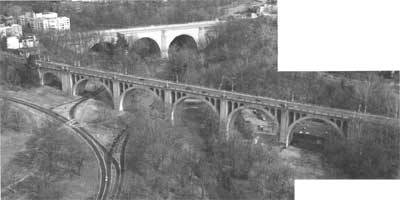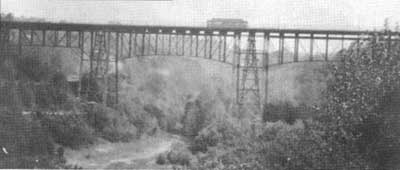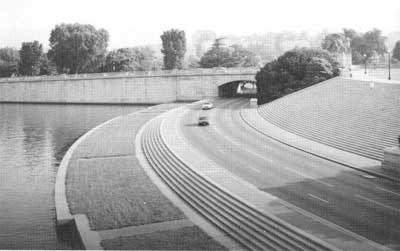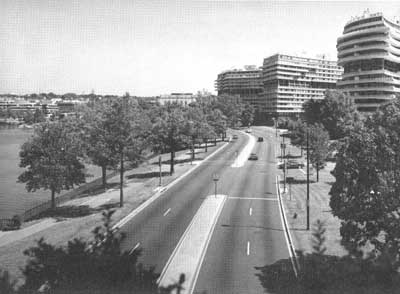 | ||
 | ||
 | ||
 | ||
 | ||
 | ||
 | ||
 | ||
 | ||
 | ||
 | ||
 | ||
 | ||
 | ||
 | ||
 | ||
 |
 |
 |
Rock Creek and Potomac Parkway
Washington, D.C.

William Howard Taft and Duke Ellington Bridges, 1992 (Boucher/HABS) |
ROCK CREEK'S BRIDGES (continued)
William Howard Taft Bridge (8)
The William Howard Taft Bridge, built 1897-1907, is probably the most notable span on the parkway. The elegant arched structure carrying Connecticut Avenue over Rock Creek valley was Washington's first monumental masonry bridge. Its high cost and elaborate ornamentation earned it the nickname "The Million Dollar Bridge." In 1931 it was officially named after former president William Howard Taft, who had lived nearby.
Taft Bridge is renowned as one of the largest unreinforced concrete bridges in the world. Designed by engineer George Morison ??? and architect William Casey, the bridge's main arches and abutments are made of concrete poured inside precast panels without the usual iron reinforcing bars. The four concrete lions on the bridge abutments are the work of sculptor R. Hinton Perry. Taft Bridge is considered a landmark in the structural and ornamental use of concrete.
The District of Columbia Department of Public Works undertook a major rehabilitation project to restore Taft Bridge during 1993-95.

Old Calvert Street Bridge, ca. 1891 (DCL) |
Duke Ellington Bridge (9)
The current bridge at Calvert Street replaced a dramatic iron truss bridge built in 1891 to carry streetcars on the Rock Creek Railway line. When the parkway was built, it was determined that the existing bridge was unable to accommodate the rise in automobile traffic. The utilitarian steel structure was also considered detrimental to the parkway setting.
The current triple-arched bridge is made of reinforced concrete faced with Indiana limestone. Architect Paul Cret and engineer Ralph Modjeski designed the new span to harmonize with nearby Taft Bridge. Its bold, simplified form reflects Cret's interest in combining modernist and neoclassical aesthetics. The sculptural panels adorning the bridge abutments were designed by Leon Hermant. Modeled in the bold, simple style of the era, they represent changing forms of transportation: sailing ship, steam engine, airplane, and automobile.
When the new bridge was under construction, the old structure was rolled 100' downstream and reconnected to the streetcar line to avoid cutting off trolley service to Washington's populous northwest suburbs. This feat was accomplished with teams of horses in slightly over nine hours. The bridge was completed in 1935 and rededicated as the Duke Ellington Bridge following the death of the Washington native and famous band leader in 1974.

Watergate Steps, 1993 (Boucher/HABS) |
Watergate Steps (10)
While technically beyond the parkway boundaries, the Watergate Steps were designed to link the parkway with the Mall and Arlington Memorial Bridge. The steps were initially conceived as a grand ceremonial gateway to Washington, but traffic concerns resulted in the construction of a roadway cutting the design in two. Audiences sat on the steps to hear the National Symphony Orchestra play summer concerts from a floating band shell anchored nearby. Increasing traffic at National Airport ended the practice in the mid 1960s.

Waterfront Section of Rock Creek and Potomac Parkway, 1993 (Boucher/HABS) |
| Introduction | Acadia | Blue Ridge Parkway | Colonial Parkway | Generals Highway | George Washington Memorial Parkway | Great Smoky Mountains | Mount Rainier | Rock Creek and Potomac Parkway | Shenandoah's Skyline Drive | Southwest Circle Tour | Vicksburg | Yellowstone | Yosemite | Discover History |
